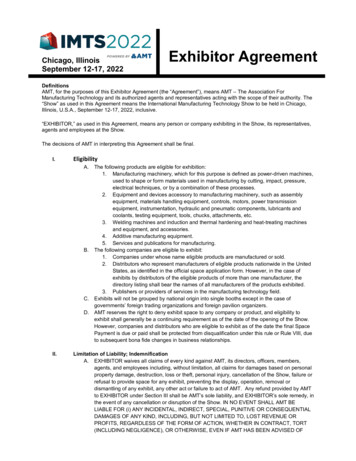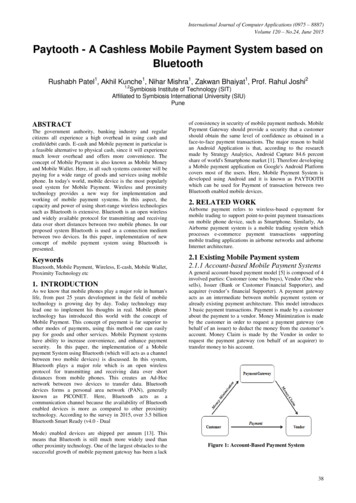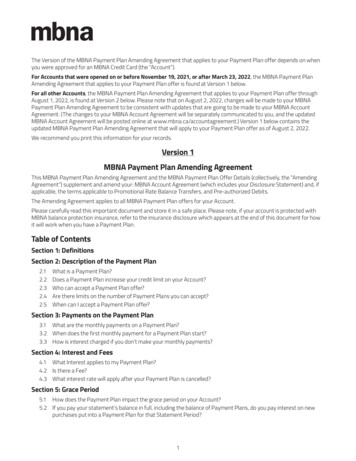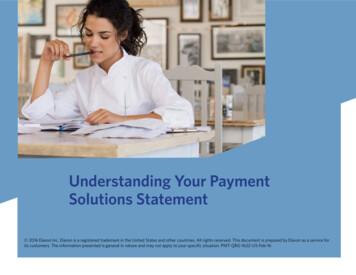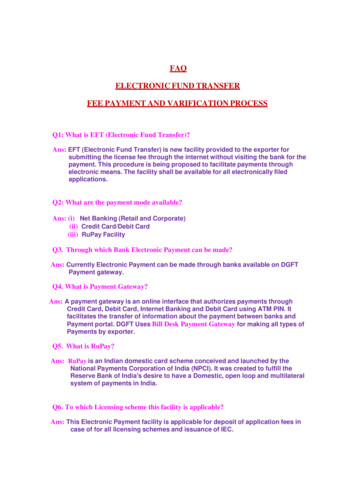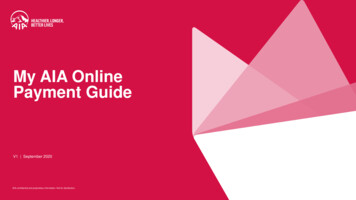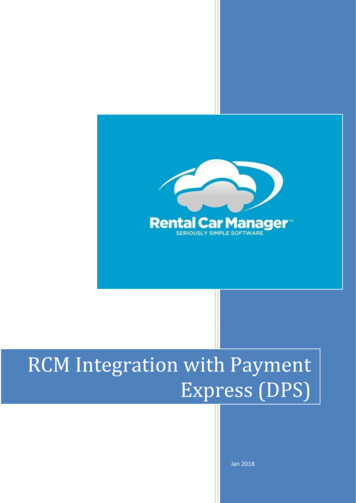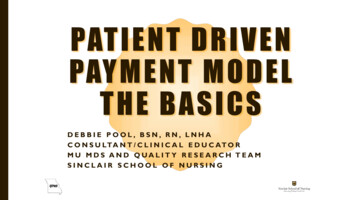
Transcription
PATIENT DRIVENPAYMENT MODELTHE BA S ICSDEBBIE POOL, BSN, RN, LNHAC O N S U LTA N T / C L I N I C A L E D U C AT O RMU MDS AND QUALITY RESEARCH TEAMSINCLAIR SCHOOL OF NURSING
WHY THE CHANGE?CMS, OIG, media and others have identified issues with the current RUG-IV case-mix model: Therapy payments under PPS are based primarily on the amount of therapy provided ratherthan the resident’s overall needs and goals. Residents demonstrating different nursing needs/costs often receive the same amount ofdollars for nursing services.PDPM: Changes the focus to the resident Improves payment accuracy Decreases administrative burden on SNF’s Reallocates services/payments to underserved Medicare beneficiaries
D IFFERENCES B ETWEEN RUG-IVANDPDPMRUG-IV: Two case-mix components:Therapy: based on volume of service providedNursing: case-mix index doesn’t reflect variations in non-therapy ancillary utilizationConstant per-diem rate: same from Day 1-Day 100PDPM: Five case-mix “adjusted” components:PTOTSLPNursingNon-therapy ancillaries (NTA) Variable per-diem adjustment which adjusts over course of SNF stay( details may be found in the Variable Per DiemSchedule available at ice-Payment/SNFPPS/PDPM.html) PT, OT, NTA components case-mix adjusted per-diem rate is multiplied against a variable per-diem adjustment factorfollowing a schedule of adjustments for each day of the stay
D IFFERENCES B ETWEEN RUG-IV AND PDPMCONTINUEPDPM: Adjustment factor for PT/ OT different from NTA due to difference in cost trajectorybetween PT/OT components and NTA. Focus is on the “unique” individual needs or characteristics and goals of each resident Improves payment accuracy Encourages a “resident-driven” holistic care model
WHAT IS “NOT” CHANGING Medicare coverage criteria is not changing: 3 midnight “Admission” hospital stay still required Medicare certification/recertification still required “Daily” skilled service still required:Therapy service 5 days/weekNursing skilled service 7 days/week NO impact on SNF ABN/NOMNC requirements No change in OBRA assessments: Admission, quarterly, annual, significant changePresumption of coverage must meet one of the following:Nursing: Extensive Services, Special Care High/Low, Clinically ComplexPT/OT groups: TA, TB, TC, TD, TE, TF, TG, TJ, TK, TN or TOSLP groups: SC, SE, SF, SH, SI, SJ, SK, SLNTA component of 12 comorbidity groups
S O W HAT “IS” C HANGING UNDER PDPM? PDPM changes the way we look at Medicare referrals and admissions Therapy is not the “revenue” driver, it is an expense. Rehab days and minutes no longer impactpayment Creates a model based on clinical characteristics addressing resident needs ICD-10 captured on the MDS will drive clinical classifications impacting reimbursement Functional scores, Section GG, will have a significant effect on payment Separate component: non-therapy ancillaries (NTA) Each resident is classified into each of the 5 components falling into different levels. 23, 000potential payment groups MDS schedule changes: Admission 5-day, Interim Payment Assessment (IPA), PPS Dischargeassessment, It eliminates 14, 30, 60, 90 day, SOT, COT, EOT assessments. The 5-day has thepotential to pay for the entire stay. New MDS items: Section I, J, O
MDS CHANGES Section I: Primary SNF DiagnosisI0020B. ICD-10 code “What is the main reason this person is being admitted to SNF?I1300 Ulcerative Colitis, Crohn’s or Inflammatory Bowel Disease diagnosis added to the NP, SP, and IPAitems sets in order to capture this diagnosis for the NTA comorbidity group score Section J: Patient Surgical HistoryJ2100-J5000. Captures any major surgical procedure that occurred during the inpatient hospital stayimmediately preceding the SNF admission . These items are used in conjunction with I0020B to classify thepatients into PT/OT case mix classification groups. Section O: Discharge Therapy ItemsO425A1-O425C5 A reporting of the entire stay look back for each discipline , mode of therapy, and amountof therapy (in minutes) Section GG: Interim PerformanceOn the IPA , GG items will be derived from a new column “5” which will capture interim performance with a“three-day window preceding and up to the ARD look back period”
C OMPONENTS O VERVIEW Patient Classifications are used for each component:ComponentCriteriaPTClinical Category, Functional ScoreOTClinical Category, Functional ScoreSLPPresence of Acute Neurological Condition, SLPrelated Comorbidity or Cognitive Impairment,Mechanically-altered Diet, Swallowing DisorderNTANTA Conditions/Comorbidities ScoreNursingClinical conditions/Needs, Functional Score(Section GG)
C OMPONENTS O VERVIEWPT/OTFor PT/OT the Clinical Categories are decreased to 4: Major Joint Replacement or Spinal Surgery Non-orthopedic Surgery and Acute Neurologic Other Orthopedic Medical Management: default category for conditions such as Pneumonia, UTI, Cardiac DiagnosisPDPM advances CMS’ goal of using standardized assessment items across payment settingsusing items in Section GG of the MDS as the basis for patient functional assessments.
C OMPONENTS O VERVIEWPT/OTCase-mix has 2 primary elements used to determine classification: Clinical Category for SNF stay I0020B Functional Status: Score derived from 10 items in Section GG, 3 from GG0130, 7 from GG01702 bed mobility items3 transfer items1 eating item1 toileting item1 oral hygiene item2 walking itemsThe higher the number, the more independent the residentThe lower the number, the more dependent the resident 16 case-mix groups each
C OMPONENTS O VERVIEWSLPSLP has 3 elements: Clinical category for SNF stay: Acute Neurologic or Non-neurologic Presence of Swallowing Disorder and/or Mechanically-Altered Diet (Section K) Cognitive Status (BIMS) and/or Presence of an SLP-related comorbiditySLP has 12 comorbidities under PDPM: SLP comorbidity tag combines conditions and services Only presence of one of the following is required to qualify:AphasiaLaryngeal CancerOral CancersCVA, TIA or StrokeApraxiaSpeech & Language DeficitsHemiplegia or HemiparesisDysphagiaTracheostomy(while resident)Traumatic Brain InjuryALSVentilator(While resident)
C OMPONENTS O VERVIEWN URSINGSame RUG-IV Major Categories: Extensive Services Special Care High Special Care Low Clinically Complex Behavior Symptoms & Cognitive Impairment Reduced Physical Function (if the resident doesn’t qualify on one of other 5, score here) 25 case-mix groupsNursing Functional Score MDS Section GG Functional Abilities and Goals: Assessed during the first 3 days of admission Documents “usual performance” Functional score ranges from 0 (dependent) to-16 (independent) Note: Nursing component will increase by 18% for residents with HIV/AIDS, 8 points into NTA count, B20 must beon SNF claim (UB04)
C OMPONENTS O VERVIEWN ON -T HERAPY A NCILLARIES (NTA)Ancillaries case-mix group includes medical resources, medical supplies, medications, labs andrespiratory services. This is where you may front load expensive medications, wound caresupplies, etc.Comorbidity score is a weighted count of comorbidities: Points are assigned for each additional comorbidity present with more points awarded athigher cost tiers Comorbidities and extensive services for NTA classifications are derived from a variety ofMDS sources, with some from item I8000 HIV/AIDS remains a SNF claim reported adjustment (8 points) Calculated based on points assigned for 50 MDS items Every point counts!!!!!
C OMPONENTS O VERVIEWNTAData sources include:HIV/AIDS-SNF claimBowel/bladder application-H0100C, H0100D ostomy, catheterizationParenteral/IV tube fed-Section KUlcers, foot skin problems-Section MSpecial treatments/ext. services-Section O IV meds, trach, vent, suctioning, transfusion, infectionDiagnosis-Section I 6 specific diagnosisAdditional active Dx. –Item I8000 28 specific diagnosis
V ARIABLE P AYMENT A DJUSTMENTS (VRB)Better targets payments under SNF PPS to reflect cost trends 2 different variable payment adjustments:PT/OT component: 2% decrease in original rate every 7 days beginning on day 21Payment daysAdjustment factor1-201.021-270.9828-340.96 .98-1000.76 Non-therapy ancillary adjustmentsDays 1-3 adjustment factor of 3.0 meaning you get 3x the rate for the first 3 daysDays 4-100 adjustment factor of 1.0
ICD-10 C ODING Replaced ICD-9 codes in October, 2015 Expanded number of codes from 13, 000 to 70, 000 Expanded from a 4-digit to a 6-digit code to allow for more specificity Clinical categories are assigned based on primary diagnosis for the SNF stay New MDS item I0020B is used to “map” to one of the PDPM clinical categories Section J (Surgical Procedures) is used to further adjust clinical classifications, if applicable(must occur during the current hospital stay) Note: Under the cms.gov PDPM resources is a PDPM ICD-10 mapping tool (revision 8/30/19)
ICD-10 C ODINGC ODING A CCURACYStep by step to coding accurately: Identify the reason for admission to SNF-diagnosis/condition, sign/symptoms Once the reason is identified, consult the alphabetical index in the book before verifying the codeselection in the tabular section Locate the main term entry Read cross-reference listed with the main term or sub-term Review entries for modifiers Interpret abbreviations, cross-references, default codes, additional character and brackets Chose a potential code and locate in the tabular list Determine whether the code is at the highest level of specificity Assign the code-discuss with the IDT, look to see if it maps versus “Return to Provider” Sequence codes correctly, primary, moving downward
S ECTION GGF UNCTIONAL S CORING Differences between RUG-IV and PDPM:Reversed scoring between RUG-IV and PDPMRUG-IV Section G-higher score indicates increased dependencePDPM Section GG-higher score indicates increased independence Payment differences related to function:RUG-IV payments increase with dependence within given RUGPDPM no direct relationship between increased dependence and increased paymentsFor PT & OT component, payment for 3 clinical categories is lower for the most & leastdependent residents PDPM uses the same basic structure as RUG-IV except:Section GG functional scoringFunctional groups decreased from 43 to 25
S ECTION GGF UNCTIONAL S CORING 10/1/18 General Clarifications: Apply to both GG0130 (self care) and GG0170 (mobility)Steps for Assessment: CMS anticipates that an interdisciplinary team of qualified clinicians is involved inassessing the resident during the three-day assessment period.Defined: “Qualified Clinician” : Healthcare professionals practicing within their scope of practice andconsistent with Federal, state and local law regulations. Important because:Nursing and therapy utilize a different languageTherapy ratings may not reflect the resident’s “usual performance” as the resident may responddifferently in therapy than on the nursing unit.
S ECTION GGF UNCTIONAL S CORING Usual Performance GG-9:Resident’s functional status may be affected by the environment or activities within the facility.Functional status should be observed in different locations and circumstances to providea more comprehensive assessment.If the resident’s functional status varies, record his/her usual ability to perform the individualactivity.Don’t record the best or worst performance but the usual performance.
MDS I TEMSNew items: I0020B-SNF Primary Diagnosis (replaces I0020A) J2100-J5000-Patient Surgical History O0425A1-O045C5-Discharge Therapy items Section GG: New column 5 for use with IPA assessmentsItems affecting payment: Primary diagnosis ( new item I0020B) Recent/past surgical procedures(new item J2100-J5000) Function scores Cognition-BIMS Depression/mood-PHQ9 Speech comorbidities Swallowing difficulties/modified diets- Section K Special conditions/services (NTA component)
MDS I TEMS MDS sections utilized by PDPM:Section B- Hearing, Speech and VisionSection C- Cognitive PatternsSection H- Bladder and BowelSection I- Active DiagnosisSection GG- Functional AbilitySection J- Health ConditionsSection K- Swallowing/Nutritional StatusSection M- Skin ConditionsSection O- Special Treatments
A SSESSMENT C HANGES Admission/5 day:ARD 1-8 daysCovers entire stay unless IPA completed Interim Payment Assessment (IPA): OPTIONALARD no later than 14 days after change in first tier classificationPays from ARD until discharge except if another IPA completedDoes not change the variable payment schedule PPS Discharge Assessment:ARD equals end date of the most recent stay (A2400C)Not used for payment purposesSection O therapy days/minutes
3 D AY I NTERRUPTIONWINDOW The count starts the calendar day of discharge( first non-covered day) and includes the 2immediately following calendar days, ending at 1159 of the third consecutive non-covered day It allows the combination of multiple stays into a single stay in cases where the residentdischarge and readmission occurs within the prescribed window It applies to instances when the resident physically leaves the facility but also cases when theresident remains but is discharged from a Medicare A covered stay Billing criteria is similar to LOA (see billing manual)Occurrence span code 74 with from/through dates of leaveValue code 81 for number of non-covered daysRevenue code 0180 for non-covered revenue
PDPM HIPPS C ODING Based on responses on the MDS the residents are classified into payment groups which arebilled using a 5-character HIPPS code. In order to accommodate the new payment groups, the PDPM HIPPS algorithm is revised asfollows:Character 1: PT/OT payment groupCharacter 2: SLP payment groupCharacter 3: Nursing payment groupCharacter 4: NTA payment groupCharacter 5: Assessment indicator Default code will change to ZZZZZ
H OW D O I G ET S TARTED ? Look at your referral and admission processes: what information do you receive from thetransferring facility? How easily can you obtain additional information to support a diagnosis and/orICD-10 code? What does your nursing admission documentation look like? Does it include accurate woundassessments, IV therapy documentation and more? Who is responsible for completion of Section GG in the first 3 days of admission? How are yougoing to ensure completion and accuracy? What is the system of communication between nursing and therapy? What is your process fortracking therapy days and minutes needed to complete a discharge assessment? Who is responsible for ICD-10 coding? Do you have a second Champion with coding knowledge?Do they have knowledge of “mapping”? How do they get to the mapping site? Do they knowhow to sequence properly?
H OW D O I G ET S TARTED ? Do you have a Restorative Nursing Program? Are the number of programs and minutes theresident receives accurately documented? Is the documentation consistent? What are your CNA’s documenting about care delivery? Is it accurate or are they just goingthrough the motions? What education have you or will you be providing for your staff: MDS Coordinator(s), BusinessOffice Manager, Therapists, Nurses, CNA’s, Social Services, Activities, Dietician? Are you able to identify best practices and develop “care paths” for specific resident conditions? Is your MDS Coordinator pulled to work the floor? Will he/she be alloweduninterrupted time to complete the CRITICAL 5 day/Admission assessment? Do you have a triple check process? If no, why not? If yes, have you revised the process to reflectthe changes? Is your software vendor ready?
H OW D O W E G ET T HERE ? Start preparing today!!! October 1, 2019 is just around the corner!!! Identify processes impacted by PDPM Talk with your therapy provider-contract revision Sharpen ICD-10 coding skills Implement programs to improve your capture of functional skills-Accuracy is Key!!! Establish or build up your restorative program Review documentation: BIMS/PHQ9, Section K, Section GG, nursing documentation, physiciandocumentation Look at staff competencies and provide needed education Look at length of stay management Get with your referral sources to identify which residents are difficult to place
T RANSITIONINGTOPDPMPrepare to transition from RUG-IV to PDPM: RUG-IV billing ends 9/30/19: must have an ARD prior to 10/1/19 to bill for SeptemberPDPM begins 10/1/19: To establish PDPM payment a 1x “transitional” IPA with an ARD no later than 10/7/19 needscompleted for the transition. Every resident currently on Medicare Part A on 9/30/19 will needthis “transitional” IPA with an ARD of 10/1-10/7/19 10/1/19 will be day 1 under the PDPM variable payment regardless of what day of the staythe resident is in If an IPA is completed with an ARD of 10/8/19 for it will be considered late and the defaultpenalty for days out of compliance will apply
R ESOURCES CMS Patient Driven Payment Model For-Service-Payment/SNFPPS/PDPM.html PDPM Implementation and policy PDPM@cms.hhs.gov Patient Driven Payment Model (PDPM) Ron Orth, RN, CMAC, CHC Relias Patient Driven Payment Model (PDPM) Prepare for Success BKD CPA’s and Advisors
QUESTIONS?
9/10/2019PDPM -S L P C A S E S TUDYP R E S E N T E D B Y W E N DY B O R E N , R N , B S N ,UNIVERSITY OF MISSOURI-COLUMBIA,Q UA L I T Y I M P R OV E M E N T P R O G R A M F O RMISSOURI (QIPMO)S PEECH L ANGUAGE P ATHOLOGYM ORE THAN JUST ST! For the SLP component, PDPM uses a number of different patient characteristics that werepredictive of increased SLP costs:– Acute Neurologic clinical classification– Certain SLP-related comorbidities– Presence of cognitive impairment– Use of a mechanically-altered diet– Presence of swallowing disorder1
9/10/201912 SLP COMORBIDITIES WERE IDENTIFIED ASPREDICTIVE OF HIGHER SLP COSTSFYI’s Conditions and services combined into a single SLP-related comorbidity flag Patient qualifies if any of the conditions/services is present A mapping between ICD-10 codes and the SLP comorbidities is available on thePDPM webpageH OW IS IT C ALCULATED ? Presence of condition(s) Comorbidities Score on the BIMS of the MDS Mechanically-altered diet Swallowing disorder2
9/10/201912 Q UALIF YING S PEECH L ANGUAGE P ATHOLOGYC ONDITIONS AND C OMORBIDITIES1AphasiaLaryngeal CancerCVA,TIA, or StrokeALSApraxiaTracheostomy (while Resident)Hemiplegia or HemiparesisOral CancersDysphagiaVentilator (while Resident)Traumatic Brain InjurySpeech & Language Deficit2H OW DO T HEY S CORE ON THE BIMS?Cognitive LevelBIMS scoreCPS scoreCognitively intact13-150Mildly impaired8-121-2Moderately impaired0-73-4Severely impaired-5-63
9/10/2019Presence of AcuteNeurologic Condition,SLP RelatedComorbidity, orCognitive ImpairmentMechanically AlteredDiet or SwallowingDisorderSLP Case Mix GroupSLP Case Mix .66Any oneNeitherSD1.46Any oneEitherSE2.33Any oneBothSF2.97Any twoNeitherSG2.04Any twoEitherSH2.85Any twoBothSI3.51Any threeNeitherSJ2.98Any threeEitherSK3.69Any threeBothSL4.19C ASE S TUDYPatient: Zane WhiteAdmitted: 11/6/2019Dx: Traumatic Brain Injury from a MVA, some aphasia, HTN, swallowing disorder, right femoralfractureADLs: more dependent assist in mostcircumstances (transfers, mobility, hygiene, toileting,eating)Nursing: depression, surgical wound to head4
9/10/2019DisciplineCategoryGG ScoreGroupCMIPaymentPTOther Orthopedic6TF1.6070 84.52OTOther Orthopedic6TF1.5940 76.97SLPNon-neurologicSI3.5113 76.17NTA0NF0.7203 41.76Nursing4CDE21.8648 143.29Non-case mix 73.35Total (1-3) 579.57Total (4-20) 496.06Average paymentper day (PPD) 501.62By day 45, PPD 483.145
9/10/2019MDS, S ECTIONS B-E Section B - Communication (vision, hearing, dental) no changes *Remember, this is a GREAT place to help someone’s communication abilitythrough an updated glasses prescription, new or adjusted dentures, hearingaids, pocket-talkers, etc.) CAREPLAN it Section C - BIMS: a patient’s cognitive status is assessed in exactly the sameway as under RUG-IV (i.e., via the BIMS or staff assessment) *Remember thiswill impact your PDPM score Sections D & E - no changes Use this opportunity to look more closely atbehaviors and analyze RCAN OW W HAT ? You’ve calculated it You’ve done your 5-day/admission assessment CHART! CHART! CHART!– Main dx– Comorbidities (that you’ve claimed) that require daily care (e.g., dementia, diabetes, swallowingproblems, etc.)– Life-skill ADLs (cater to section GG wording rather than typical section G ADLs)– Tell the whole story - what you’re doing for them, why they’re here, how they’re improving ordeclining– Care Plan!REMEMBER - Every story will be different. There’s no place forcopycat charting in PDPM.6
Nursing: case-mix index doesn't reflect variations in non-therapy ancillary utilization Constant per-diem rate: same from Day 1-Day 100 PDPM: Five case-mix "adjusted" components: PT OT SLP Nursing Non-therapy ancillaries (NTA) Variable per-diem adjustment which adjusts over course of SNF stay( details may be found in the Variable .



